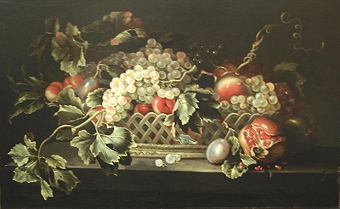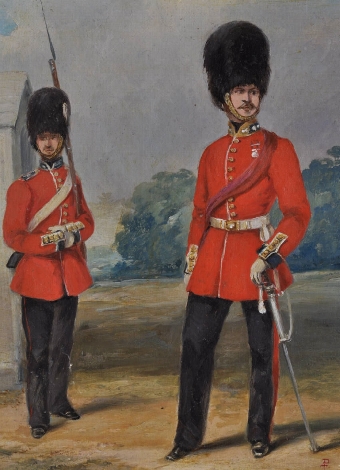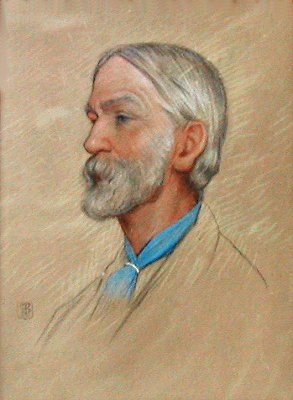The Prince William, Duke of Cumberland (William Augustus; 26 April 1721[1] ? 31 October 1765) was a younger son of George II of Great Britain and Caroline of Ansbach, and a military leader.He was born in Leicester House, Leicester Fields (now Leicester Square), London, where his parents had moved after his grandfather, George I, was invited to take the British throne. On 27 July 1726[2], at only four years old, he was created Duke of Cumberland, Marquess of Berkhamstead in the County of Hertford, Earl of Kennington in the County of Surrey, Viscount of Trematon in the County of Cornwall, and Baron of the Isle of Alderney. The young prince was educated well, becoming his parents'' favourite (so much so that his father would later consider ways of making him his heir in preference over his eldest brother, Frederick, Prince of Wales). At Hampton Court Palace, apartments were designed specially for him by William Kent.
From childhood, he showed physical courage and ability. He was intended, by the King and Queen, for the office of Lord High Admiral, and, in 1740, he sailed, as a volunteer, in the fleet under the command of Sir John Norris, but he quickly became dissatisfied with the Navy, and, early in 1742, he began an Army career. In December 1742, he became a Major-General, and, the following year, he first saw active service in Persia. George II and the "martial boy" shared in the glory of the Battle of Dettingen (27 June 1743), and Cumberland, who was wounded in the action, was reported as a hero in Britain, thus founding his military popularity. After the battle he was made Lieutenant-General.
In 1745, having been made Captain-General of the British land forces, at home and in the field, the Duke was again in Flanders, as Commander-in-Chief of the allied British, Hanoverian, Austrian and Dutch troops. Advancing to the relief of Tournay, which was besieged by Marshal Saxe, he engaged the great general, in the Battle of Fontenoy, on 11 May 1745. Had the Duke been supported by the allies in his attack on the superior positions of the French army, Fontenoy would probably not have been recorded as a defeat for Britain. Cumberland himself was in the midst of the column which penetrated the French centre, and his conduct of the retreat was cool and skilled.
As the leading British general of the day, he was chosen to put a decisive stop to the successful career of Charles Edward Stuart, known as the Young Pretender, in the Jacobite Rebellion of 1745.Recalled from Flanders, Cumberland proceeded with his preparations for quelling the insurrection. He joined the midland army under Ligonier, and began pursuit of the enemy, but the Stuart''s retreat from Derby disrupted his plans, and it was not until they had reached Penrith, and the advanced portion of his army had been repulsed on Clifton Moor, that Cumberland became aware of just how hopeless an attempt to overtake the retreating Highlanders would then be. Carlisle having been retaken, he retired to London, until the news of the defeat of Hawley at Falkirk roused again the fears of the English people, and centred the hopes of Britain on the Duke. He was appointed commander of the forces in Scotland.
Arriving in Edinburgh on 30 January 1746, he at once proceeded in search of the Young Pretender. He made a detour to Aberdeen, where he spent some time training the well-equipped forces now under his command for the peculiar nature of the warfare in which they were about to engage. He prepared his army to withstand the aggressive charges on which all Highland successes depended and he reorganised the forces and restored their discipline and self-confidence.
On 8 April 1746, he set out from Aberdeen, towards Inverness, and, on 16 April, he fought the decisive Battle of Culloden, in which the forces of the Young Pretender were completely destroyed. Cumberland told his troops to take notice that the Jacobite enemy''s orders were to give no quarter to the "troops of the Elector", and they took the hint to reciprocate; there is no evidence of any such orders. On account of the merciless severity with which the fugitives were treated, Cumberland received the nickname of "Butcher" from some, and he is still known to some Scots as "Butcher Cumberland".[1] [2]This taunt was used for political purposes in England, and Cumberland''s own brother, the Prince of Wales (who had been refused permission to take a military role on his father''s behalf), seems to have encouraged the virulent attacks upon the Duke. Like Oliver Cromwell in Ireland, Cumberland dared to act in a way which would be held against him by some for the rest of his life, and terrorised an obstinate and unyielding enemy into submission. How real the danger of a protracted guerrilla war in the Highlands was may be judged from the explicit declarations of Jacobite leaders that they intended to continue the struggle. As it was, the war came to an end almost at once, and most of the populations of Scotland, England, and the colonies, however, lionised him as their deliverer from the Jacobite menace - for instance, he received an honorary degree from the University of Glasgow.
Cumberland preserved the strictest discipline in his camp. He was inflexible in the execution of what he deemed to be his duty, without favour to any man. At the same time, he exercised his influence in favour of clemency in special cases that were brought to his notice. Some years later, James Wolfe spoke of the Duke as "for ever doing noble and generous actions".The Duke''s victorious efforts were acknowledged by his being voted an income of ?40,000 per annum, in addition to his revenue as a Prince of the Royal House. The Duke took no part in the Flanders campaign of 1746, but, in 1747, he again opposed the still-victorious Marshal Saxe and received a heavy defeat at the Battle of Lauffeld, or Val, near Maestricht, on July 2, 1747.
During the ten years of peace from 1748, Cumberland occupied himself chiefly with his duties as Captain-General, and the result of his work was clearly shown in the conduct of the army in the Seven Years'' War. His unpopularity, which had steadily increased since Culloden, interfered greatly with his success in politics, and when the death of the Prince of Wales brought the latter''s son, a minor, next in succession to the throne, the Duke was not able to secure for himself the contingent regency, which was vested in the Dowager Princess of Wales, who considered him an enemy.
In 1757, the Seven Years'' War having broken out, Cumberland was placed at the head of a motley army of allies led by Great Britain to defend Hanover. At the Battle of Hastenbeck, near Hamelin, on 26 July 1757, he was defeated by the superior forces of d''Estr?es. In September of the same year, his defeat had almost become disgrace. Driven from point to point, and at last hemmed in by the French, under Richelieu, he capitulated at Zeven monastery, on 8 September 1757, agreeing to evacuate Hanover. He played a major role as second-in-command to Duke Ferdinand of Brunswick later in the war.
His disgrace was completed on his return to England by his father, George II''s, refusal to be bound by the terms of the Duke''s agreement. In chagrin and disappointment he retired into private life, after having formally resigned the public offices he held. In his retirement, he made no attempt to justify his conduct, applying in his own case the discipline he had enforced in others. For a few years, he lived quietly at Cumberland Lodge in Windsor, and subsequently in London, taking but little part in politics. He did much, however, to displace the Bute ministry and that of Grenville, and endeavoured to restore Pitt to office. Public opinion had now set in his favour, and he became almost as popular as he had been in his youth. After the accession of his nephew, George III, he vied with his sister-in-law, Augusta of Saxe-Gotha, for the role of regent in times of emergency. Shortly before his death, the Duke was requested to open negotiations with Pitt for a return to power. This was, however, unsuccessful.The Duke passed away on Upper Grosvenor Street in London, on October 31, 1765 apparently from a heart attack brought on by his massive, life-long weight problem, and he is currently buried beneath the floor of the nave of the Henry VII Lady Chapel in Westminster Abbey.
British Honours
KG: Knight of the Garter, 1730
KB: Knight of the Bath, 1725
PC: Privy Counsellor, 1742
Cumberland Farms was named on his behalf.
Academic
1751-1765: Chancellor of Trinity College, Dublin
The tabard of Blanc Coursier Herald, Cumberland''s private officer of armsThe Scottish Highland town of Fort Augustus takes its name from a British Army fort which was named in his honour.Many places in the American colonies were named after him, including the Cumberland River, the Cumberland Gap, the Cumberland Plateau, and the Cumberland Mountains, in addition to several counties and towns named "Cumberland" in the mid-18th century.
Antiques.co.uk Ref: QN9RNQRK
- Materials:
- Oil on Canvas
- Width (cm):
- 88.90 x 76.20 (cm) (30 x 35 ins.)














